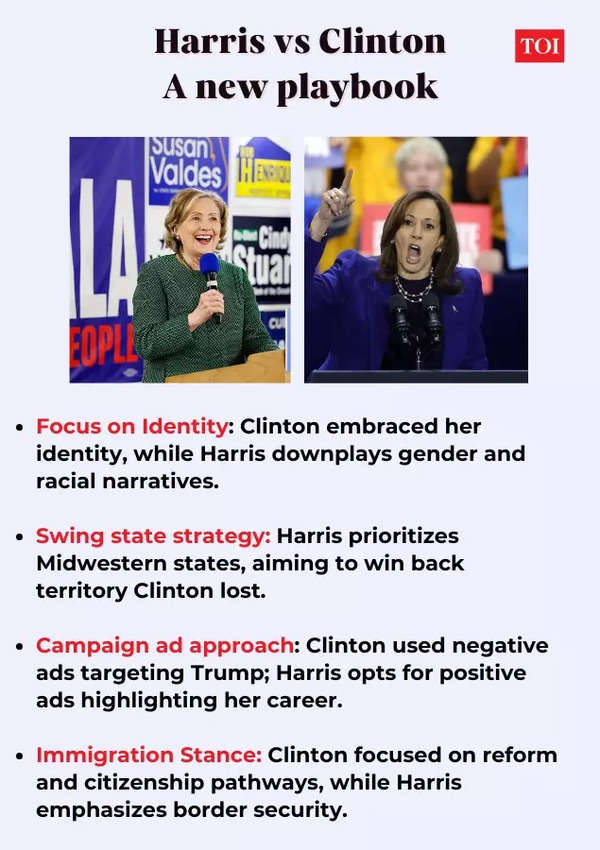
After President Joe Biden left, vice chairman Kamala Harris launched a strategy that was markedly different from the one Hillary Clinton ran against former US President Donald Trump in 2016. Despite the fact that both people have faced a difficult Democratic challenge in Trump, Harris has chosen a different strategy: leaning toward issues that are relevant beyond identity and staying away from Clinton’s “break the glass ceiling” tale.
Gender politics and shaping campaign
Hilary Clinton frequently emphasized the importance of breaking the “highest and hardest crystal sky,” bringing the issue of female justice into the forefront of her campaign during her historic campaign as the Democratic Presidential candidate in 2016. But, Kamala Harris has never mentioned it in her acceptance speech during her nomination acceptance speech, and has never given a damn about it.
Harris has chosen a technique that underplays gender, despite the symbolic value of her potential as the first woman and Asian-American president, believing that British voters may prefer her record to the narrative of a traditional “first,” taking inspiration from the Obama campaign.
Otherwise, she has placed her landmarks on Western states like Wisconsin—territory Clinton lost in 2016 after skipping a last visit. During her strategy, Harris has put a lot of effort into making plans and decisions.
She has n’t left her identity, after all
While Harris does n’t explicitly use her identity for campaign, her supporters amplify it for her. Grassroots groups, alliance and significant clubs, have propelled her campaign’s information through online gatherings and events.
Her supporters, including her vice presidential candidate, have been vocal about the traditional nature of her election, but Harris has stayed aside from it, betting that voters care more about her credentials than about her eminently groundbreaking as a member.

plan advertisements over assault
In stark contrast, Harris ‘ marketing plan and Hilary Clinton’s are both. Hilary launched tides of adverse ads attacking Trump, especially in the administration’s final month, highlighting his divisive speech and indecent feedback. Harris, nevertheless, has opted for a more healthy approach.
Her advertising feature her job as an attorney general, the relevance of Roe v. Wade being overturned, her summer job at McDonald’s, and her wars against strong businesses, painting a picture of her experience and work with only a limited amount of ads attacking Trump.
avoiding or humoring personal assaults
‘ Turned black’,’ single catlady’,’ Slept her way to the top’, Kamala has had to face some personal attacks similar to what Hilary had to face up in 2016. Yet her response has been far more restrained. While Clinton took Trump’s attacks head-on, Harris has chosen to either ignore or deflect, often with humor.
When Harris was asked to respond to Trump’s racial attack in a CNN interview, Harris shook her head and said,” Same old, tired playbook”, ignoring it with” Next question, please” in a restrained response.
Changed stance on immigration
Immigration is where Harris ‘ strategy, one of the most pressing issues in the election cycle, most drastically differs from Clinton’s. Republicans have mounted criticism against the Biden administration’s approach to the border, which Harris has had to contend with directly. She has pledged to tighten asylum laws and strengthen border security in response, which distances her from both Biden and her previous stance as a senator. Hilary Clinton, by contrast, advocated for a pathway to citizenship, an Office of Immigrant Affairs, and increased resources for asylum seekers and immigration attorneys, positioning herself as an immigration reformist.
Harris ‘ pivot on immigration is a response to a campaign that adapts to the political reality that immigration is a contentious and contentious issue for many voters. Instead of framing it as a reform-based policy, she has taken a security-first approach, with an emphasis on reducing illegal crossings and expediting asylum cases.
While Trump was able to defeat the last woman he faced in an election, Hillary Clinton, much has changed since then. His policies and appointments have been subject to more public scrutiny as a result of the Supreme Court’s decision to overturn Roe v. Wade, which resulted in his conviction for sexual abuse. But polls show that the race is still very close, with Trump’s popularity only growing.
With only a few days until the US election, Harris and Trump are still in a tight race, both nationally and in crucial battleground states. Harris is betting that a new strategy, one that emphasizes pragmatic policy change rather than “breaking the glass ceiling,” will ultimately lead to a different outcome for Donald Trump’s election.



